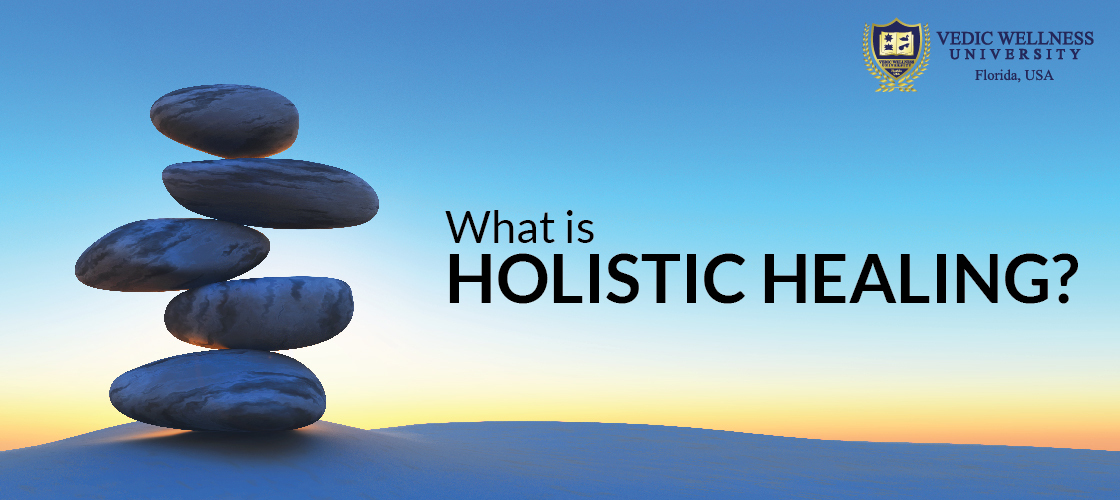What is Holistic Healing?
Introduction
One of the most misinterpreted and overused terms is ‘holistic’ healing. A holistic doctor or practitioner is one who uses natural remedies as opposed to synthetic drugs. The term ‘holistic’ got its name from the Greek word ‘holos’ which means ‘whole’ and in holistic health is a perfect balance of emotional, physical, mental, and spiritual wellbeing.
What is Holistic Healing as per Ayurvedic Perspective?
According to Ayurvedic principles, an imbalance in the doshas creates problems in the body organs or systems. Appropriate medicines can be taken once the imbalance gets assessed to make the patient feel better.
One must give attention to diet and lifestyle as they are the vital components of any Ayurvedic regime. Practicing yoga for about 15-20 minutes helps the medicines to work more effectively in the body with the treatment.
For knowing the meaning of healing, one must understand that holistic recovery is to bring a balance for the imbalance by aligning with the natural state of functioning. When something is out of place, it comes in the form of physical or emotional pain and the natural harmony breaks down.
Holistic healing acknowledges that the root cause of a physical illness is non-physical and the healing works when life gets the approach from all aspects of being emotional, physical, mental and spiritual.
A holistic approach, therefore, is considered more effective as change happens on all levels resulting in a positive change that lasts long along with improving the overall quality of life.
Because holistic healing addresses the imbalances on all levels instead of one or two, thus it becomes a life-long process for achieving overall life balance. The ultimate goal is to align the body, mind, and soul promising the individual a happier, healthier, and balanced state of being.
What makes an individual feel healthy?
The four levels taken into consideration are- physical, emotional, mental and spiritual science, which our body radiates in the form of energy.
These four levels operate interdependently, and thus when one of the class gets affected, the other levels are also affected. Just like when you feel depressed, your overall physical health also misbalances or vice versa. Thus, in holistic healing, the emotional body state influences our physical health either positively or negatively, and this chain reaction effect is how holistic healing works.
In our life, we encounter different life situations like people, places, events, and they challenge us on either of the three levels physical, emotional, mental or spiritual.
On a physical level, while we intake healthy enzymes and nutrients in our bodies, they help to make our bodies healthy and vitalize it. But, when toxins and chemicals directly or indirectly are taken, the body becomes dysfunctional and weak.
On an emotional level, we confront the challenges when we can handle life well and learn to move on. And if we are not able to take them, they become subconscious blockages.
These factors help to keep the four levels aligned; thus, we feel happy and healthy.
Now how holistic healing works?
There are two goals of holistic healing, to balance each level and to balance each level with one another.
In the first goal, we focus our efforts because the second goal happened naturally when the four levels are balanced individually. When all levels are balanced, one achieves wholeness.
Now the alignment achieved in the holistic healing is by the purification on all the levels. When our mind is pure, the energy flows freely through all systems and without any resistance. As time moves on, we learn how to balance the imbalances and ways to correct them.
Practically we all aim for a balanced lifestyle, but in life, we learn to live with at least one level out of balance. Sometimes we are at our worse and not even on balance on at least one level, but we do function at our best when we are in total alignment.
Ayurveda, we all know is an ancient concept of treatment and one of the earliest cultures of India. In Ayurveda, a common belief is that there are five significant elements of the universe; seven aspects of the body are primary and three biological energies or ‘doshas’. Just like any other natural treatments, the balance and interconnectedness of these internal and external elements are the soles of wellness.
Ayurvedic treatment has eight disciplined treatments which are called branches or limbs. The limbs are as follows:
- Internal medicine or Kayachikitsa
- Surgery or Shalya Tantra
- Treatment of the eyes or Shalakta Tantra
- Gynecology and Pediatrics or Kaumarabhritya
- Toxicology or Agada Tanta
- Psychiatry or Bhuta Vidya
- Rejuvenation an anti-aging or Rasayana
- Reproductive and enhancing sexual power or Vajikarana
Practitioners who practice Ayurvedic holistic healing guide the patients with the help of the eight limbs of Ayurveda for balance and moderation in one’s life.
Conclusion
Holistic healing explained that this healing is all about looking at the person as a whole and not just their physical symptoms of a disease but taking into account the mental and social factors also.
When a person fails to find relief through traditional medicines for their ailments, they start to explore other avenues. Holistic treatment is not about alternative medicine or complementary medicines but what distinguishes it from conventional drugs is the focus of treatment.
When you have traditional or alternative medicines, the main focus is on physical health but not on overall health. As said, holistic healing focuses on all the aspects of a person, and thus the only objective is to bring harmony and balance to body, mind, and spirit in the body.
Holistic healers can recognize the discomforts in one’s body or mind, and these are the symbols of an imbalance. These issues are mainly because of the physical problem, lifestyle choices, or emotional issues which affect the whole body of the person.
Our life situations cause us to respond to physical, emotional, mental, and spiritual states all at the same time.



One Response